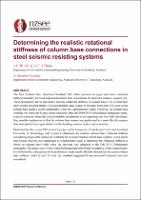| dc.description.abstract | The New Zealand Steel Structures Standard, NZS 3404, provides an upper and lower rotational stiffness boundary for fixed and pinned column base connections for structural analysis, respectively. These boundaries aim to represent a realistic rotational stiffness of column bases. For a fixed base steel seismic resisting frame, it is expected that some degree of inelastic behaviour will occur at the column base under a severe earthquake, when the superstructure yields. However, no column base yielding was observed in steel frame structures after the 2010/2011 Christchurch earthquake series, even in structures where the desired inelastic mechanism in the superstructure was fully developed. One possible explanation is that the column base connections performed in a more flexible manner than anticipated, hence generated a smaller bending moment under a given rotation.
Motivated by this, a new PhD research project at the University of Auckland (UoA) and Auckland University of Technology (AUT) aims to determine the realistic column base rotational stiffness considering all possible sources of flexibility for several common column base systems. A non-linear time history analysis was undertaken as a preliminary study to determine the rotational stiffness at which no column base yields when the structure was subjected to the Feb 2011 Christchurch earthquake. The paper starts with a research background and a brief description of the research plan. It is followed by a discussion of the preliminary study results. Results showed that the actual column base stiffness could be half of what the standard suggested if non-structural elements were not considered. | |

